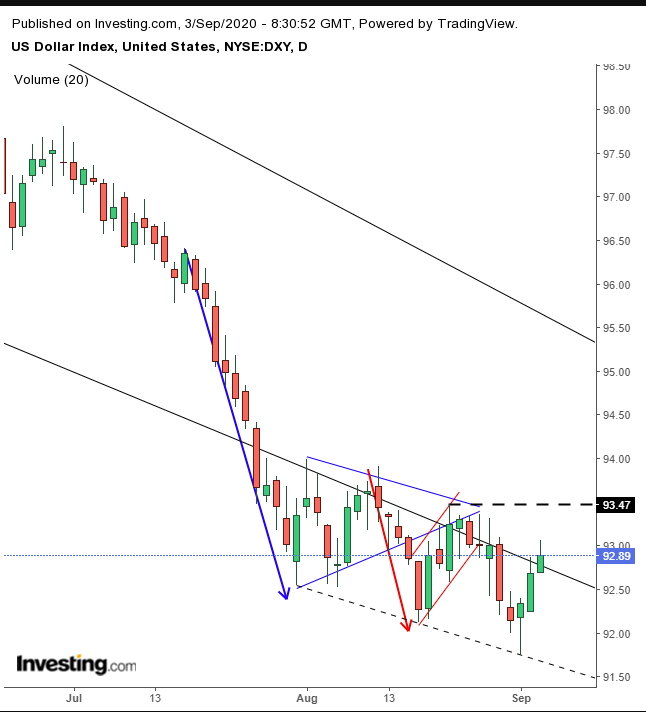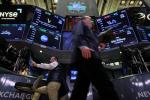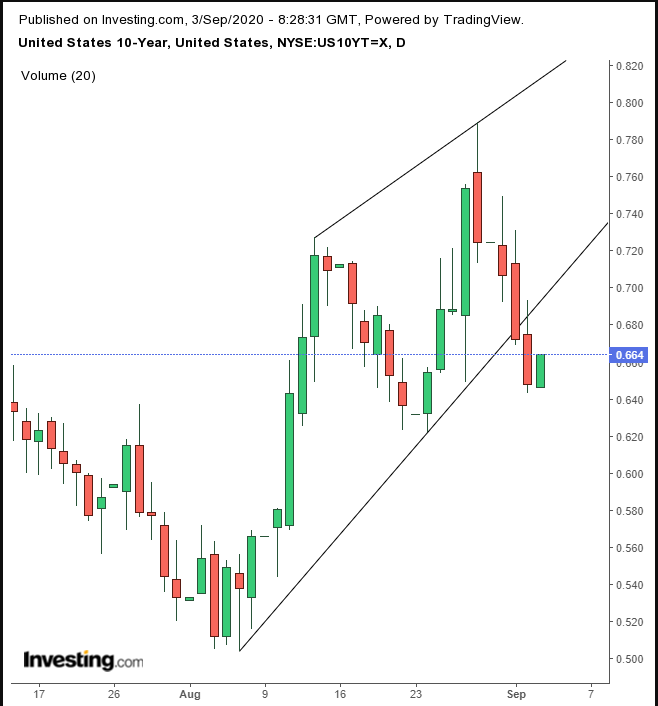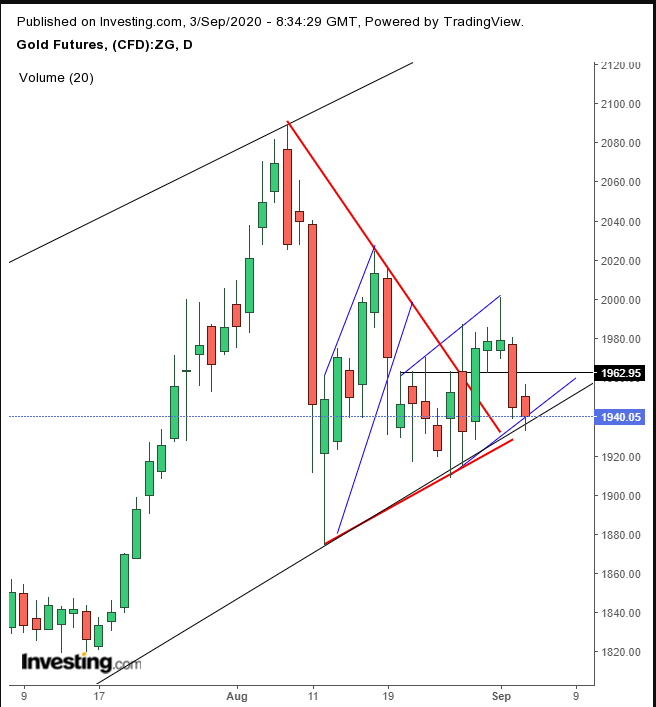
- All Instrument Types
- Indices
- Equities
- ETFs
- Funds
- Commodities
- Currencies
- Crypto
- Bonds
- Certificates
Please try another search

Opening Bell: Tech Sector Sell-Off Continues; Dollar Climbs, Gold Drops

- US and European markets rally
- Rotation out of tech stocks continues
- Gold drops on stronger dollar and weak demand expectations
- U.S. initial jobless claims for the week ended Aug. 29 are due Thursday.
- Eurozone retail sales data for the month of July to be released on Thursday.
- U.S. nonfarm payrolls, reported on Friday is forecast to show payrolls continued to rebound in August from virus lows.
- Futures on the S&P 500 Index decreased.
- The Stoxx Europe 600 Index rose 0.9%.
- The MSCI Asia Pacific increased 0.1%.
- The MSCI Emerging Markets Index declined 0.2%.
- The Dollar Index increased 0.3%.
- The euro fell 0.4% to $1.1808.
- The pound declined 0.4% to $1.3291.
- The onshore yuan was little changed at 6.835 per dollar.
- The yen was little changed at 106.21 per dollar.
- The yield on 10-year Treasuries increased less than one basis point to 0.65%.
- The yield on 2-year Treasuries gained less than one basis point to 0.14%.
- Germany’s 10-year yield sank one basis point to -0.48%.
- Britain’s 10-year yield fell one basis point to 0.224%.
- Japan’s 10-year yield declined one basis point to 0.038%.
- West Texas Intermediate crude dipped 0.6% to $41.25 a barrel.
- Brent crude declined 0.9% to $44.05 a barrel.
- Gold weakened 0.6% to $1,932.01 an ounce.
Key Events
Three of the four major US contracts, the S&P 500, Dow Jones and NASDAQ advanced on Thursday as markets extended their rally amid a shift out of the technology sector, suggesting sentiment about the broader economy is improving. The small cap Russell 2000, however, was slightly in the red.
The Stoxx Europe 600 jumped at the open driven by banks and travel shares, after French President Emmanuel Macron's government announced a 100 billion-euro stimulus plan.
Treasury yields fell on the Federal Reserve's Beige Book release and the dollar strengthened.
Global Financial Affairs
The rotation out of tech shares pushed the S&P 500 1.54% higher yesterday, its biggest daily jump in more than two months, since June 30, when the benchmark rose similarly, on a percentage-basis. The move extended the index's second quarter rally to 20% after its best quarter since 1998.
The move out of technology also suggests improved sentiment on the broader economy may result in a return to equilibrium in the markets. During the last few months the tech sector has had a significant price-to-earnings (P/E) uplift, as the pandemic has resulted in more of us are working from home. Non-tech sectors have not benefited from a similar surge in valuations.
The rally in Europe followed the same pattern as the US rally. Both were carried by financials and other shares that had fared poorly during the lockdown and social distancing.
Yesterday’s most notable losers in the US were big-name tech stocks, including Apple (NASDAQ:AAPL), Zoom (NASDAQ:ZM) and Tesla (NASDAQ:TSLA). If this rotation turns from a one-off to an ongoing market reality, it would indicate a more bullish market sentiment overall. An announcement of a coronavirus vaccine would underpin that sentiment. Otherwise we may just see another sell-off.
Asian shares were mixed bucking the global rising trend, as the session that followed the US close appeared more sensitive to a most disappointing private jobs report offsetting Fed largesse and optimism on a vaccine.
Chinese shares both on the mainlaned via the Shanghai Composite, (-0.6%), as well as those in the financial hub listed on Hong Kong’s Hang Seng, (-0.45%), ended lower, as high-flying consumer firms sold off together with tech, after a rally that lasted for weeks pushed valuations higher, pricing out bargain seeking investors.
In the background, trade difficulties with the US weighed on sentiment. Incongruously, other Asian equities rallied on signs of recovery in China’s services sector.
South Korea’s KOSPI (+1.3%) outperformed, gaining for a third straight day. Samsung Electronics (KS:005930) led the rally after American NVIDIA (NASDAQ:NVDA) announced that Samsung would manufacture a series of powerful gaming chips for the American company. The weakening won boosted stocks further with foreigners being net buyers.
Yields, including for 10-year Treasuries, dropped on Wednesday following the new employment data.
The yield pared yesterday’s losses but remained below a rising channel after a four-day decline pushed it through the previously bullish pattern, now expected to weigh on the trend.
The dollar rose for the third day, after yesterday’s biggest jump in almost two weeks.

The dollar is testing the bottom of the falling channel it breached, slipping from session highs, demonstrating resistance.
Dollar strength and equity exuberance pushed gold down for the second day.
Gold found support at the bottom of its rising channel.
There's a serious tug of war between bulls and bears evolving as the price is developing a second consecutive rising flag—which may carry a bearish punch after preceding drops—even after the price completed a pennant expected to be a continuation pattern that extends the rising channel.
Bitcoin rebounded off a month-long H&S top.
This corresponds to the dollar losing its grip off the daily high.
Oil prices extended a drop for the second day, falling to more than a monthly low on lower U.S. refinery demand projections. Also, the previous weak dollar that boosted oil is now strengthening, adding to the weight on the price of oil. With crude in something of a holding pattern, three fundamentals factors could trigger its next move.
The technical picture is not overly bright either. The price of oil blew out a potentially bullish pennant, as it fell through the bottom of a rising channel. Yesterday’s 50 DMA support failed, and today the price tests the 200 DMA.
Up Ahead
Market Moves
Stocks
Currencies
Bonds
Commodities
Related Articles

Trump threatens EU tariffs, creates confusion about Mexico and Canada duties Dollar rebounds but gold slides again Nvidia falls in after-hours trading as earnings fail to set...

Gold Consolidates Ahead of Key US Data Releases The gold (XAU/USD) price was relatively unchanged on Wednesday as markets remained cautious ahead of upcoming inflation data and...

For every trader, choosing a reliable broker is a cornerstone of success. Achieving consistent gains in trading is not a walk in the park as it is, and you don't want any extra...
Are you sure you want to block %USER_NAME%?
By doing so, you and %USER_NAME% will not be able to see any of each other's Investing.com's posts.
%USER_NAME% was successfully added to your Block List
Since you’ve just unblocked this person, you must wait 48 hours before renewing the block.
I feel that this comment is:
Thank You!
Your report has been sent to our moderators for review









Add a Comment
We encourage you to use comments to engage with other users, share your perspective and ask questions of authors and each other. However, in order to maintain the high level of discourse we’ve all come to value and expect, please keep the following criteria in mind:
Enrich the conversation, don’t trash it.
Stay focused and on track. Only post material that’s relevant to the topic being discussed.
Be respectful. Even negative opinions can be framed positively and diplomatically. Avoid profanity, slander or personal attacks directed at an author or another user. Racism, sexism and other forms of discrimination will not be tolerated.
Perpetrators of spam or abuse will be deleted from the site and prohibited from future registration at Investing.com’s discretion.